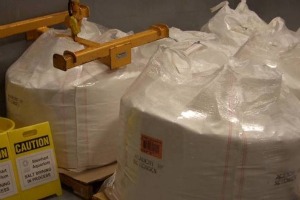In addition to the salt, there are 11 additional ingredients to the CAS salt formula. Laurie’s demonstrating her new checklist that ensures the mix is correct 100% of the time.

The Academy recently converted over from Instant Ocean (the Bisquick for salt water aquarists) to our own blend. The salt water team took months to investigate and test the new mixture that reduces our cost from $0.12 per gallon to under $0.08 per gallon. This is a big deal when you are making over 2.7 million gallons per year!
Just before making the transition, the cisterns where the water is mixed and stored needed to be cleaned. In a joint effort, the Aquarium Staff and the Engineers drained the cisterns, washed down the silt, and collected it for disposal. Arnel’s in this tank after most of the water was drained and the space certified safe for people to enter.

Ever wonder how the glass roof is cleaned?
The panes of glass that ring the living roof house thousands of solar cells and keep the perimeter of the building dry. Unlike a regular roof, the glass needs to be washed regularly to remove any debris and deposits that can permanently etch the glass. A soft brush at the end of a long pole, with filtered water that removes any chemicals and minerals that will spot the glass, are the only tools used – no chemicals.

The same technique is used on most of the building’s glass surfaces, both inside and out.
Ever wonder how we spread compost on a steep slope?
Spreading compost to improve the planting conditions on the south slope is difficult. The process used to be carrying buckets of the stuff by hand, up and down a hill, trampling plants and compacting the soil in the process. Enter jet mulching! Specialty trucks use compressed air to push to compost through a flexible tube, literally blowing the mulch onto the hillside. Three trucks made quick work of our hillside in just a few hours. They placed three times the amount of mulch in a quarter of the time, for the same cost.

Ever wonder what went into the Academy's LEED Platinum certification?
The Academy earned its LEED (Leadership in Energy and Environmental Design) Platinum certification for New Construction (NC) with a score of 54 out of a possible 69 points. The LEED NC was designed to guide and distinguish high-performance commercial and institutional projects. Our building was graded on six categories that included sustainability, water efficiency, energy use, and indoor environmental quality, and was based on how the building was constructed. We are now nearly complete with our submission to the United States Green Building Council (USGBC) for our Existing Building Operations and Maintenance (EB-OM) certification. The EB-OM checklist has a total of 110 points and helps us measure the operations, improvements, and maintenance with the goal of maximizing efficiency and minimizing environmental impacts. The project team are in the homestretch of this nearly two year project!
37.7699 -122.467174
 Courtesy of Kevin Manalili.
Courtesy of Kevin Manalili.



